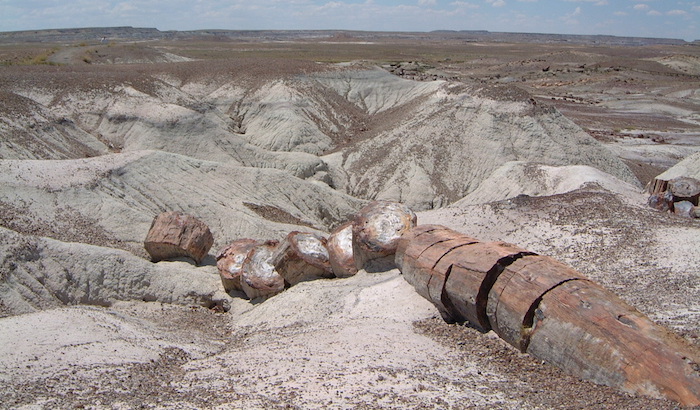In the remote desert of Arizona, in Petrified Forest National Park, there sits an odd structure. It looks like a Native American pueblo. But instead of being made of adobe or stone, its walls are made from chunks of quartz the size of your head. This is the Agate House. It’s an archaeological marvel, and when placed in the fictional setting of your RPG campaign, it’s an adventure site that is its own plot hook!
This post is brought to you by beloved Patreon backer Arthur Brown. Thanks for helping keep the lights on! If you want to help keep this blog going alongside Arthur, head over to the Patreon page – and thank you!

For many miles around the Agate House, the land is littered with the fossilized remains of ancient trees. 218 million years ago, in the Triassic period, this area was a forest. Sometimes when the trees fell, floodwaters quickly covered them in silt. Silica in the groundwater permeated these fallen trees. Over millions of years, the dissolved silica replaced the organic structures in the tree, molecule by molecule, leaving behind a perfect copy made entirely of quartz!

When Native Americans arrived in the area, they found these stone logs eroding out of the hillsides. Everything was preserved, down to the whorls in the bark. Some of the logs were as much as 200 feet long and six feet in diameter. But because quartz is brittle, all the logs had broken into short lengths. The effect was almost as if someone had come along with a saw and cut the logs into sections. The smaller sections – from thick branches and the trunks of younger trees – made convenient building materials. So people stacked them into walls (either dry or mortared), and built their homes from them. The remains of hundreds of such structures are known.

Image credit: Marine 69-71. Released under a CC BY-SA 3.0 license.
In the first half of the 20th century, archaeologists only knew of one such building: the Agate House, built sometime between 1050 and 1300. Only the foundations of its walls had survived. But in the 1930s, government workers partially rebuilt the house based on archeological findings. No one would do that today, but the ethos of archaeology was a little different back then.

The house is made of one 10-foot-by-20-foot-ish room surrounded by seven smaller rooms, almost like outbuildings. The walls are about a foot thick. None of the rooms have doors – access is through a hole in the roof. It’s a defensive setup common to the pueblos of the region. To get in, you have to climb up a ladder propped against the wall. If the family living inside hauls up their access ladder, no one outside can get onto the roof and then inside unless they climb the wall or come back with their own ladder. The reconstruction also included a window in the main room, but that was later deemed inaccurate.

Image credit: Marine 69-71. Released under a CC BY-SA 3.0 license.
At your table, you can drop the Agate House anywhere, as long as you drop a landscape of petrified wood along with it. It would be a lot of fun if the fossilized wood in the walls remembers the land as it once was. At night, the stone logs dream of their Triassic glory days, and a ghostly forest springs up around the Agate House!
While fleeing pursuers, perhaps the party enters a landscape littered with petrified logs. They come upon the Agate House empty and abandoned, its access ladder fallen beside it. Normally, no adventurer worth her ten-foot pole would stay in a convenient abandoned house. But the Agate House is very defensible, and there are pursuers hot on the party’s tail. Your PCs might just be tempted into spending the night in the house.

At night, when the ghostly forest grows around the house, the PCs will be besieged not by their pursuers, but by a spectral Postosuchus kirkpatricki dreamed into existence by the house. Note that this still has to be an easier fight than facing the pursuers on open ground. Otherwise, you’re punishing your players for making smart decisions, and they’ll trust you less going forward.

The first light of day returns the landscape to normal. PCs may find the bodies of their pursuers mangled by dinosaurs and drowned in unexpected rivers and streams. If the pursuers were locals who knew of the house’s curse, they may have given up the chase instead, imagining that the PCs were surely killed by the house.






